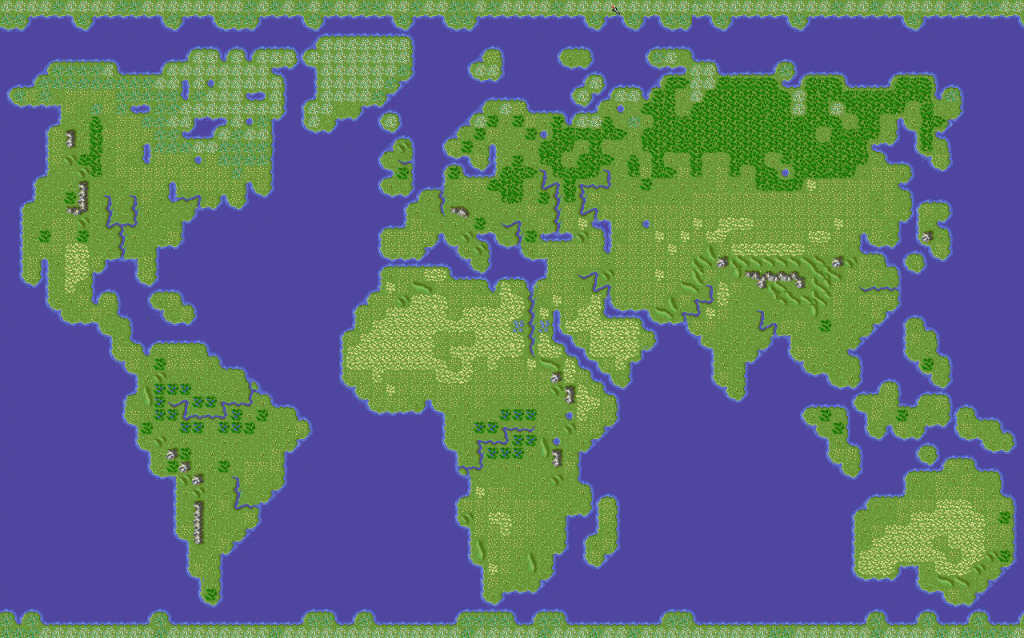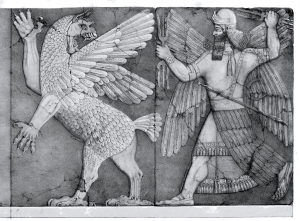Computers were originally developed to get large amounts of data processed faster and more efficiently. However, these large, mainframe computers were very expensive and required lots of space. In the late 1970s, computer technology changed rapidly, making it possible for individuals to have their own computers, and the micro-computers of Atari, Apple, and IBM were born. In the 1980s, those early computers became cheaper and more powerful, and software developers began creating a variety of applications for these micro-computers, from business applications to personal record-keeping and beyond. One genre of programs was the burgeoning industry of gaming. One of the first games applied to micro-computers was Atari’s Pong, released on its own Atari platform in 1980, a convert from the video arcade games of the 1970s. Another of this type was Frogger, which became available to micro-computers in the early 1980s. These games are still surprisingly popular, and they have generated multiple copycats over the years. However, the combination of cheap micro-computers and games like Frogger and Pong only fueled a new and hitherto untapped desire for home video games like never before. New contenders entered the scene, and one of the greatest of the gaming industry, Sid Meier, began a game-coding career that has become legendary. He has a rich history in video game programming, and it’s quite an interesting story.

Sid Meier is a well-known creator of flight simulators, having created game titles such as Solo Flight (released in 1984), F-15 Strike Eagle (released in 1985), and more. He created these at MicroProse, a computer game company founded in 1982 by himself and Bill Stealey.1 He and Stealey had a great chemistry: Meier would create the games, and Stealey would handle the business. During this partnership, Meier developed a number of flight simulator games because of Stealey’s passion for military-focused computer games, specifically flight simulators. He had been in the Air Force and he felt the strong urge to show everyone what it was like to fly a combat plane. And in those early years of MicroProse, they made a great team. In 1988, Sid first met Bruce Shelley, and they both worked on creating the F-19 Stealth Fighter simulation game. This “took up much of [Shelley’s] first year” at MicroProse.2 But Meier began to grow tired of simply churning out simulation games every year. He wanted to create something new. Something different. After working with Shelley on the simulator, Meier decided that Shelley would be a perfect partner to help him work on his new project: Civilization.
They had a difficult beginning, since much of MicroProse, specifically Bill Stealey, did not want to provide the funding to develop Meier’s new game concept. They were not particularly interested in the idea itself, and would rather have Meier focus on projects that were projected to make money, and at the time, that meant working on a simulation game called Railroad Tycoon. The game was released in 1990. Comparing it to Civilization, Railroad Tycoon‘s gameplay is a little similar to Civilization‘s. The map itself is based on tiles. The player chooses what they want to establish on that specific tile, such as a railroad or a building. In Civilization, the player is able to choose what they would like to place in a specific tile, just like in Railroad Tycoon. But as they were developing Railroad Tycoon, it only made Meier want to create an even larger scale game: one that would simulate the development of civilizations from meager beginnings all the way to the space age. Shelley was given the first playable version in May of 1990 on a 5 1/4” floppy disk. This was huge. Meier’s ability to create a game as complex as Civilization was already a great feat during this time period. It’s also very impressive that he was able to fit all these ideas onto a small disk. Shelley would then play-test it, and then talk with Meier on what was working and what was not. And, surprisingly, “’Meier would revise the prototype in the afternoon and leave a new version for [him] to test in the morning.”3 This first version of the game was playable in real-time, and Meier felt that it was lacking in excitement: “Watching the civilization grow was like watching paint dry.”4 Real-time game-play means that everything develops continuously at a set speed, and the players often must wait for their actions to finish developing before they can do anything else. Nevertheless, the game-development process went on for about six months. Both Meier and Shelley felt that the game wasn’t turning out the way that they wanted it to.5 It also did not help that upper management at MicroProse was not impressed by the game, and wanted their attention directed toward the Railroad Tycoon series, which Stealey thought the company should further develop based on its initial success. But time spent on Railroad Tycoon was not, in fact, spent in vain.
After completing Railroad Tycoon, the duo returned to Civilization. In the second version of the game, they changed the game style to turn-based rather than real-time, and this is what made the game much more interesting. Instead of waiting for something to finish in real-time, such as a building to be finished or a unit to be completed, players would decide what they wanted to happen the next turn. Everything that can be done is in one turn, and this gave players something to look forward to. This allows them to plan what they want to accomplish on their next turn. This was where the phrase “one more turn” was born, and Civilization would be destined to be a hallmark of computer gaming from then on. But there was an additional element that Meier and Shelley added to the game-play. It was the idea of it being a “god-game.” This type of game-play has become common in computer gaming, and can take on many forms. Some of the earliest successes in “god-game” play were SimCity (by Maxis, released in 1989) and Caesar (by Sierra Entertainment, released in 1992). This type of play allows the player entire control over crucial variables of the game. In Civilization’s case, this meant that the player could decide where they want to start their civilization, and they can also decide who to attack and who to become allies with. They can decide how to allocate various assets and resources that would affect the future development of their civilization. This allowed for the game to be much more dynamic, and it gave the game refreshing game-play every time the player starts a new game. For example, if one were playing the role of Genghis Khan, one might prepare to declare war on another “player.” Before the player can do this, however, they have to “produce” several military units. This may take many turns. Every turn will be very important because the player must take care of his or her civilization, yet also somehow progress forward on a number of fronts at the same time. The turn-based gameplay allows one to plan out one’s attack, and that is what makes the gameplay so interesting. In Rise of Nations, a rival game, everything is in real time, which makes it difficult to plan out an attack. At all times, the player is susceptible to attack, and the player is not given any time to strategize.

Meier also created a “technology tree” in the second version. In this tree, the player can see and read about different technologies that the player can “discover,” or “research.” Each technology offers the player enhanced assets for the current turn. And the technologies unlock the possibilities of even higher technologies, each enabling the further improvement of things like weapons and buildings, and more. Technologies start with simple things such as pottery, or the development of the calendar, and then they get much more complicated, with subjects such as fertilizer, or interchangeable parts. Each technology has its own benefits to the player as well. For example, with the technology of fertilizer, farms can produce more food without needing to be located near fresh water. (Farms located near sources of water usually produce more food.) This leads to cities growing faster because farms are much more efficient. Thus players can plan their civilization-building strategies around certain technologies that would foster directions of development they find advantageous. Technologies make the gameplay much more interesting, and players can develop their own game style. This is one of the aspects that gives Civilization its unique gameplay.

The final version of Civilization was released to the public in 1991. It was an instant hit and was named “Strategy Game of the Year” by Origin Awards.6 Unfortunately, MicroProse fell into debt a couple of years after the release of Civilization, and was sold to Spectrum Holobyte, another game developer at the time.7 That did not stop Sydney, since, thankfully, he was not involved in MicroProse’s fall. He has joined Firaxis Games since then, and has released many sequels to his signature game Civilization, with Civilization VI being the most recent release in 2016. One could look at Sid Meier’s career and call it magnificent, and many would agree. Civilization has given Sid Meier a very successful and steady career. It has allowed him to grow as a game developer, since, with every release, he incorporates new ideas to make playing Civilization even more fun and challenging than the original.
- John Gaudiosi, “Interview: Sid Meier reflects on 25 years of Civilization,” PC World, https://www.pcworld.com/article/3133567/software-games/interview-sid-meier-reflects-on-25-years-of-civilization.html. ↵
- Benji Edwards, “The History of Civilization,” Gamasutra, https://www.gamasutra.com/view/feature/129947/the_history_of_civilization.php? ↵
- Benji Edwards, “The History of Civilization,” Gamasutra, https://www.gamasutra.com/view/feature/129947/the_history_of_civilization.php? ↵
- Benji Edwards, “The History of Civilization,” Gamasutra. https://www.gamasutra.com/view/feature/129947/the_history_of_civilization.php? ↵
- Benji Edwards, “The History of Civilization,” Gamasutra. https://www.gamasutra.com/view/feature/129947/the_history_of_civilization.php? ↵
- “1991: List of Winners,” Origin Awards. ↵
- Benji Edwards, “The History of Civilization,” Gamasutra. https://www.gamasutra.com/view/feature/129947/the_history_of_civilization.php? ↵



29 comments
David Kamel
I just want to start off by saying that I have been playing video games since I was born. I actually am very acquainted with Civ and used to play it all the time on the Xbox version with my brothers. I really think Sid Meier is one of the legendary developers that deserves all the credit he gets and more just like Tom Clancy, Martin O’Donnell, Jason Jones, and all of the OG Bungie devs. Developers need to get more credits for the extremely hard work it takes to make a game and even fix a game and I do think the industry needs to have more patience.
Elizabeth Maguire
I have never heard of any of the Civilization series games but they do seem pretty interesting. It is really fascinating that how ten years after Pong a game as complex as the Civilization game series could have been created during this time. Before reading this article I did not know that Sid Meier was a creator of flight simulators.
Gabriel Dossey
I have only ever been aware of Civilization in the Civilization V and Civilization VI. I also dabbled in Sid Meier’s Pirates. I never knew that there was such a rich story to the development of Civilization. I do not like how long the game takes. I found it really interesting that the entire game was able to be put onto a floppy disk and am impressed at the tenacity used in its creation.
Sebastian Carnero
I haven’t played any of the Civilization series games, but they seem pretty interesting. It is incredible how ten years from Pong, something as complex as that could be created. There is no wonder why he has a steady career as a game developer, he was creative, he loved his job and he was very dedicated to it. It wasn’t even a day for Meier to give a new version of the prototype.
Dylan Coons
The Civilization series is one of the best strategy games of all time. Saying the game is a work of art is being modest. being able to create an empire only to have it destroyed by a nuclear Gandhi is the most annoying/ satisfying things about the game and truly brings to life the creativity the player and Sid Meier brings to the game.
Noah Bolhuis
As a child I played civilizations, and I can honestly say it was one of the most fun games I had ever played. Thanks to Sid Meiers, I spent countless hours in my back room play this game over and over. It is fun to see the story of how he was able to achieve success. Every successful person failed many times before making it to their peak, and this is another perfect example. His persistence and perseverance were what got him to where he is today, and it got me the game that I played the most as a child.
Reagan Meuret
This article is very fascinating to me because I have played the Civilization series many times, but I never thought to think of who created it or how it was created. I find the games very fun and it is hard for me to wrap my head around the concept of creating a video game. I can tell from this article that it is a very long, slow, and tedious article.
Christopher Hohman
Nice article. I am a huge fan of the civilization game series. It sounds like they went through alot in order to produce the first version of this game. They did such a great job though. The game has really withstood the test of time. I love how the developers have continued to expand on the number of things that you can do with your civilization. The newest version of the game Civilization 6 is just great I think. The visuals are really cool, but they have not gotten away from the core of the first game. It still has the original turn based formula. Love Love these games
Honoka Sasahara
I respect game developers so much because they have numerous skills such as dealing with technology, imagining new idea, or understanding customers’ needs. I thought Sid Meier one of the such respectable people and was amazed by his creativeness. I found his turn-based game style the most interesting. It makes good use of player’s mentality and prompts them to want to play it more and more. It is the needless point in creating game programs.
Didier Cadena
I have played Civilization before, but I had no idea about the impact that it made. I had no idea who Sid Meier was before reading this article, so it was great to be able to read a little about him. It was also amazing to read that Meier is still involved in the development of the Civilization series. The article does a great job of putting all of the information together and still engages the reader to continue reading it.